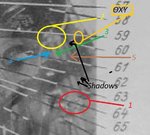Tony Hill
Tech Sergeant
Guys, is there anyone who knows what this is/may be? The bracket holds a device of some sort and that device has a tube which goes back through a hole in the instrument panel. (that is present on most early Spitfire I instrument panels, both those with and without the bracket)
The Bracket:

And here, a blurry shot of the instrument on the prototype.

It looks like some type of pressure instrument to me.
Regards and thanks in advance
Darryl
The Bracket:
And here, a blurry shot of the instrument on the prototype.
It looks like some type of pressure instrument to me.
Regards and thanks in advance
Darryl

